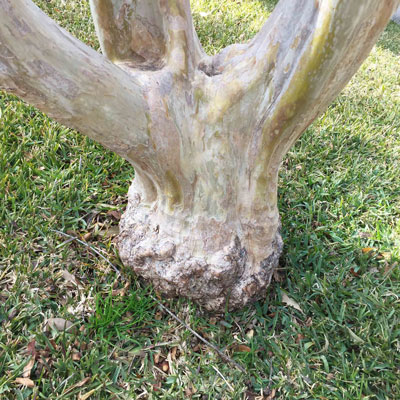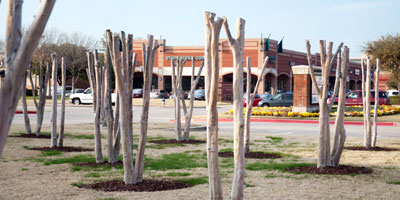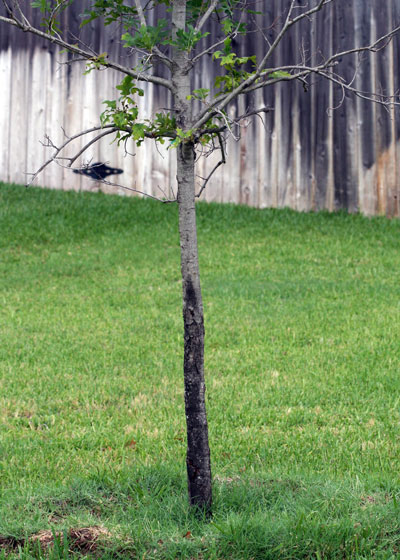What We Do to Our Trees
I try always to take the positive approach to gardening. But there are times when I just have to show some of the crazy things I see around me. I’ve brought a collection.

Horticulturists refer to these as “mulch volcanoes.”
• Mulch volcanoes If a little mulch is a good thing, then mounds must be wonderful. Right? Wrong! How can anyone get water down to the roots, when a mound shelters them and sheds water like a roof? In reality, these mulch piles probably conceal the fact that there’s a mound of soil just beneath them – soil that came out of the hole. Like a kid who tries to hide his broccoli beneath half a dinner roll, it was just easier to pile the soil up than to cart it off-site.

Natchez crape myrtle trunk has grown completely around its old support rope.
• Girdling guy wires, ropes It’s very important that new shade trees be held vertically until their roots can develop into the soil. There is no “do-over” when a tree is out-of-plumb (except, of course, digging and resetting it). You can’t pull it back into vertical, no matter how hard you try.
That said, you must remove the guy wires, straps or rope before it does damage to the tree’s enlarging trunk. Even a piano wire wrapped around a tree’s trunk will eventually kill it by cutting off the flow of manufactured sugars through the phloem.

Line trimmer has turned crape myrtle trunk into a gnarly mess.
• Line trimmer trauma This does the same damage as a girdling guy wire. It severs the phloem, and the sugars that have been manufactured in the leaves can’t be transported down to the roots. You can ruin a tree that’s been growing for 35 years in just 35 seconds if you’re careless with your trimmer. Stay at least a couple of inches away from the trunk.

No caption can explain this horrible practice!
• Copycat topping This is one of the most baffling habits in horticulture. Why would anyone ruin the natural form of a lovely tree, in particular a crape myrtle? There is simply no defense for the practice, yet thousands of homeowners and even commercial maintenance companies insist on butchering their crape myrtles every winter. Stop topping!

Why you don’t leave portions of branches in place when you trim!
• Stubbed nubs Limbs should always be pruned virtually flush with the trunk or with another branch. When you leave a stub, invariably the tree will fail to heal properly, and decay will begin to develop a couple of years down the road. If you’re removing a large branch, do it in three steps. Make an undercut one-third of the way into the bottom of the branch 15 inches out from the trunk. Then, move a few inches farther out, and cut through the branch from the top-down. The weight of the branch will cause the bark to be stripped, but the undercut will stop it before it impacts the trunk. Third, remove the 15-inch stub to within one-quarter inch of the trunk. Research has shown that leaving that small amount of branch collar will speed up the healing.

Sunscald is taking its toll on an unprotected young Shumard red oak.
• Unprotected exposure Some young trees have little or no bark on their trunks. They shade one another when they’re growing in the nursery, but when we plant them out into our landscapes, they’re suddenly exposed to the worst of the Texas summertime sun, and sunscald and subsequent borer invasion are likely to follow two or three years later.
What types are most vulnerable? Without any question, Shumard red oaks and Chinese pistachios, but others can also succumb. The solution is simple. Apply a paper tree wrap from the nursery or hardware store at the time of planting, and leave it in place for 12 to 24 months. That’s pretty much a non-negotiable practice with new red oaks.
